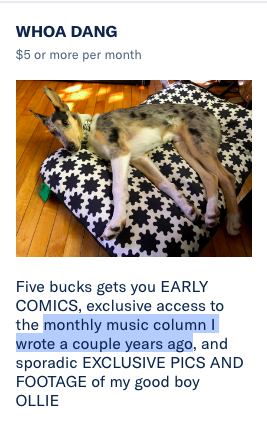Two types of Patreon strategies — and when to use them
 There are two very different approaches to Patreon, and — depending on your webcomic and its readers — you may want to favor one over the other. However, some of the best Patreon approaches feature both.
There are two very different approaches to Patreon, and — depending on your webcomic and its readers — you may want to favor one over the other. However, some of the best Patreon approaches feature both.
Support vs Exclusive
The two types of Patreon campaign are best characterized as Support and Exclusive. In a Support-based Patreon, you focus on offering free content and encourage your followers to contribute to the Patreon to keep the free content flowing. In an Exclusive Patreon, you offer exclusive content in addition to your free content — and the only way to access those exclusives is through Patreon.
Support

Patreon started out as a support-based crowdfunding app. Nearly all of the first campaigns were support-based, and many popular Patreons continue to be support-based. Amanda Palmer, for example, runs a support-based Patreon that has nearly 14,000 backers. Although she offers many rewards that only Patreon backers can obtain, all of her videos — her main content — are free. Webcomics’ Jeph Jacques runs a similarly support-based Patreon campaign supported by nearly 7,000 backers. Again, although there are some rewards that are considered exclusives (like his music column from a couple years back), but his core content — his comics — remain free.
A Support based Patreon approach is going to fall victim to the sociopsychological phenomenon of diffusion of responsibility. In other words, whenever there’s a group of people, the individuals feel less responsibility to take action when required to do so. In other words, “I don’t have to do it because someone else will.” Most webcomic readers are going to feel very little responsibility to support a comic that’s being delivered to them as long as it’s being delivered to them. (And, let’s face it, after it an artist finds it impossible to continue production, it’s too late to take responsibility for supporting the comic.)
Due to this diffusion of responsibility, a support-based Patreon relies on one of two options:
- A very, very large number of followers
- A relatively small audience that is highly engaged.
In the former, the creator relies on sheer numbers for success. If only 1% of 100,000 followers take action, that’s still 1,000 backers. In the latter option, the audience may not be vast, but their engagement — the passion they take in the artist’s content — is so high that a greater percentage of them take action (and, likely, take action at the higher reward tiers).
If you have a readership that numbers above the hundreds-of-thousands, a Support-based Patreon might be the best route for you.
Exclusive content
Of course, if you don’t have hundreds-of-thousands of readers, you may want to consider a Patreon campaign that features exclusive content. In this approach, you still offer free content, but you also offer a second line of content that’s available only to higher-tier Patreon backers.
You free content acts as a loss-leader to introduce new potential backers to the exclusive content you’re offering on Patreon. The exclusive content is just that — accessible only on Patreon, and only for higher-level backers.
A mix of both…
Of course, some of the best Patreon campaigns feature a little Support and a little Exclusive Content. I’m very much in favor of exclusive content, but my own Patreon page has a $2 tier that’s strictly Support-based. In fact at that level, I think the reward should reflect the Support-based approach fully — offering very little as a reward besides, perhaps, early access to the free comic.
And, of course, be sure to keep a clear distinction between rewards and exclusive content. An eBook that’s only available to Patreon backers isn’t the same as a line of comics that are exclusive to Patreon. The former is a reward — but not, necessarily exclusive content. Exclusive content is generally ongoing work in the artist’s core strength.




Recent comments